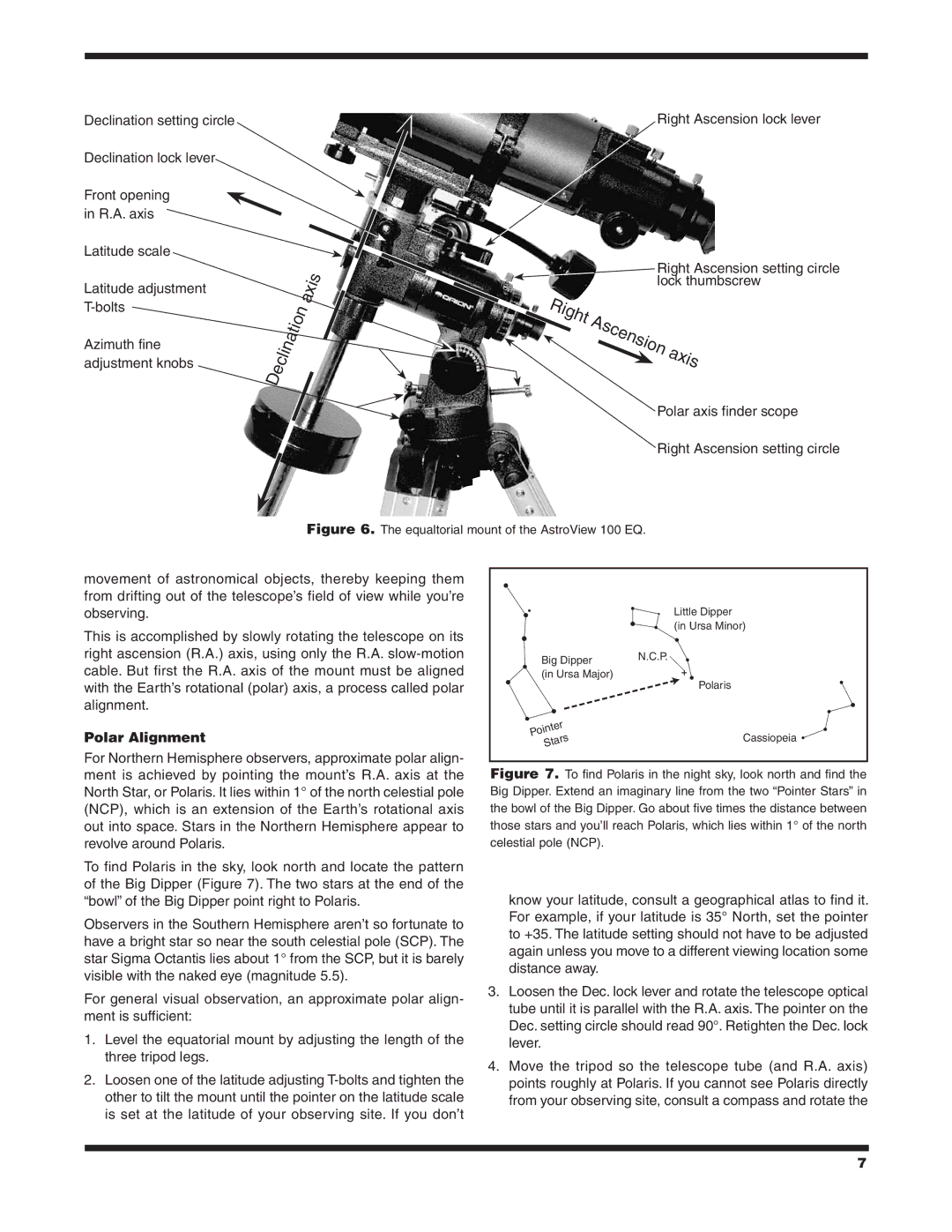
Declination setting circle
Declination lock lever
Front opening in R.A. axis
Latitude scale
Latitude adjustment
Azimuth fine adjustment knobs
Declination | axis |
|
Right Ascension lock lever
Right Ascension setting circle lock thumbscrew
Right | Ascension |
|
| axis | |
|
|
Polar axis finder scope
Right Ascension setting circle
Figure 6. The equaltorial mount of the AstroView 100 EQ.
movement of astronomical objects, thereby keeping them from drifting out of the telescope’s field of view while you’re observing.
This is accomplished by slowly rotating the telescope on its right ascension (R.A.) axis, using only the R.A.
Polar Alignment
For Northern Hemisphere observers, approximate polar align- ment is achieved by pointing the mount’s R.A. axis at the North Star, or Polaris. It lies within 1° of the north celestial pole (NCP), which is an extension of the Earth’s rotational axis out into space. Stars in the Northern Hemisphere appear to revolve around Polaris.
To find Polaris in the sky, look north and locate the pattern of the Big Dipper (Figure 7). The two stars at the end of the “bowl” of the Big Dipper point right to Polaris.
Observers in the Southern Hemisphere aren’t so fortunate to have a bright star so near the south celestial pole (SCP). The star Sigma Octantis lies about 1° from the SCP, but it is barely visible with the naked eye (magnitude 5.5).
For general visual observation, an approximate polar align- ment is sufficient:
1.Level the equatorial mount by adjusting the length of the three tripod legs.
2.Loosen one of the latitude adjusting
| Little Dipper | |||
| (in Ursa Minor) | |||
Big Dipper | N.C.P. | |||
|
|
|
| |
(in Ursa Major) |
|
|
| Polaris |
|
|
| ||
|
|
|
| |
Pointer |
|
|
| Cassiopeia |
Stars |
|
|
| |
|
|
|
| |
Figure 7. To find Polaris in the night sky, look north and find the Big Dipper. Extend an imaginary line from the two “Pointer Stars” in the bowl of the Big Dipper. Go about five times the distance between those stars and you’ll reach Polaris, which lies within 1° of the north celestial pole (NCP).
know your latitude, consult a geographical atlas to find it. For example, if your latitude is 35° North, set the pointer to +35. The latitude setting should not have to be adjusted again unless you move to a different viewing location some distance away.
3.Loosen the Dec. lock lever and rotate the telescope optical tube until it is parallel with the R.A. axis. The pointer on the Dec. setting circle should read 90°. Retighten the Dec. lock lever.
4.Move the tripod so the telescope tube (and R.A. axis) points roughly at Polaris. If you cannot see Polaris directly
from your observing site, consult a compass and rotate the
7
